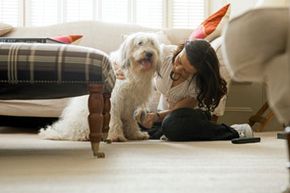 “Grooming is a perfect time to examine your dog for potential problems. John Howard/Lifesize/Thinkstock
“Grooming is a perfect time to examine your dog for potential problems. John Howard/Lifesize/Thinkstock
It’s not negotiable — you have to take your dog into your vet’s office for a full physical exam every year (and sometimes more often, especially if you have an older dog). However, that doesn’t mean you shouldn’t perform your own exams at home on a regular basis. If you’re familiar with what’s normal for your pooch, you’ll be more likely to notice when something isn’t right. You’ll also know when you can take of problems yourself and when it’s time to get professional help. Hopefully, you’re already brushing your dog regularly, so that’s a perfect time to do a home exam. He’ll enjoy getting extra attention from you, and it’s a good opportunity to spend some quality time together. Begin when your dog is a puppy or when you first get him, so he’ll be used to being handled.
To start off, check out your dog’s coat. Look for things like dry skin, dandruff, fleas or "flea dirt" (a nice way of saying flea feces). If you’re worried that your dog has fleas, brush out his coat over a white piece of paper or a light-colored towel. If you see any little black specks, moisten them with a drop of water or smear them with a damp cotton ball. If you see a red streak, then it’s definitely flea dirt, and your dog has a flea infestation. You can remove fleas from his coat using a fine-toothed flea comb. Dip the flea comb in a bowl of soapy water; the fleas will drown in the water, and the soap holds them under and keeps them from jumping out of the bowl. Although you can get rid of the fleas that are currently on your dog, more will just jump right back on him unless you use a preventive flea treatment. There are over-the-counter versions available, but generally, they’re not very effective (and flea collars can be dangerous). Consult with your vet to find out which one is best for your dog.
Read on to find out what else you should be looking for when performing a physical exam of your dog — including why it’s important to smell his ears!
Get a Little Closer, Puppy
As you comb or brush your dog, pay attention to his reaction. Does he enjoy the feel of the brush going through his fur, or does he flinch when you touch a certain spot? If the latter is true, examine the area for lumps or sores. If you find an area that seems painful, note its appearance. Is the lump hard or soft? Oozing or rough? Observe the area carefully, and make an appointment to get it checked out by your veterinarian as soon as possible.
After going over your pup’s coat and body, examine his eyes, ears, nose and mouth. All of these features can tell you a lot about your dog’s overall health. His eyes should be bright and clear, with no redness or runny discharge. Tear stains beneath the eyes may also indicate a problem, depending on your dog’s breed. Besides looking into your dog’s ears — they should be dry, with no discharge — give them a sniff, too. It sounds strange, but an unpleasant odor in dogs’ ears can signal an ear infection. It may be the only sign if his ears look fine and he’s behaving normally otherwise. While cleaning your dog’s teeth (if you don’t already, it’s never too late to start), take a look around his mouth. His gums should be a healthy pink — unless he normally has black gums, of course. If they appear pale, bluish, bright red or bleeding, there could be a serious problem, and it’s time for a visit to the vet.
Finally, examine your dog’s paws. Are there any scrapes or abrasions? Do his nails need to be trimmed? Long nails can get snagged or broken, and they’re difficult for your dog to walk on. If they get too long, your dog can even become lame. After your overall exam, finish with a nice, soothing massage. This is a good way to deepen the bond between you and your dog. You may want to follow up with a healthy treat as well, especially if you’re just starting out with your exams.
Keep a written record of your home exams so you know what’s normal for your dog. In addition to your physical exam, take note of his eating, sleeping and elimination habits. Then you can refer to this record regularly, and you’ll notice immediately if something has changed. If there is a serious problem, these records will be invaluable to your veterinarian when he or she is trying to diagnose and treat your dog.
These home exams mean getting even closer to your dog than ever before, but isn’t he worth it? With your help, your pooch pal can lead a happy and healthy life.
Lots More Information
Related Articles
- Home Remedies for Dogs With Porcupine Quills and Foxtails
- Home Remedies for Dogs With Sore Paws and Sunburn
- Home Remedies for Dogs With Worms
More Great Links
- Vet Vocabulary
Sources
- AAHA. "Grooming Your Pet." American Animal Hospital Association. 2011. (June 3, 2011) http://www.healthypet.com/petcare/DogCareArticle.aspx?art_key=03d2162c-1d41-467f-944b-b3e922b93896
- Eldredge, Debra M., et al. "Dog Owner’s Home Veterinary Handbook." John Wiley and Sons. 2007.
- WebMD. "Ear Care for Dogs." WebMD. 2011. (June 5, 2011) http://pets.webmd.com/dogs/guide/ear-care-dogs
- WebMD. "Eye Care for Dogs." WebMD. 2011. (June 3, 2011) http://pets.webmd.com/dogs/guide/eye-care-dogs


